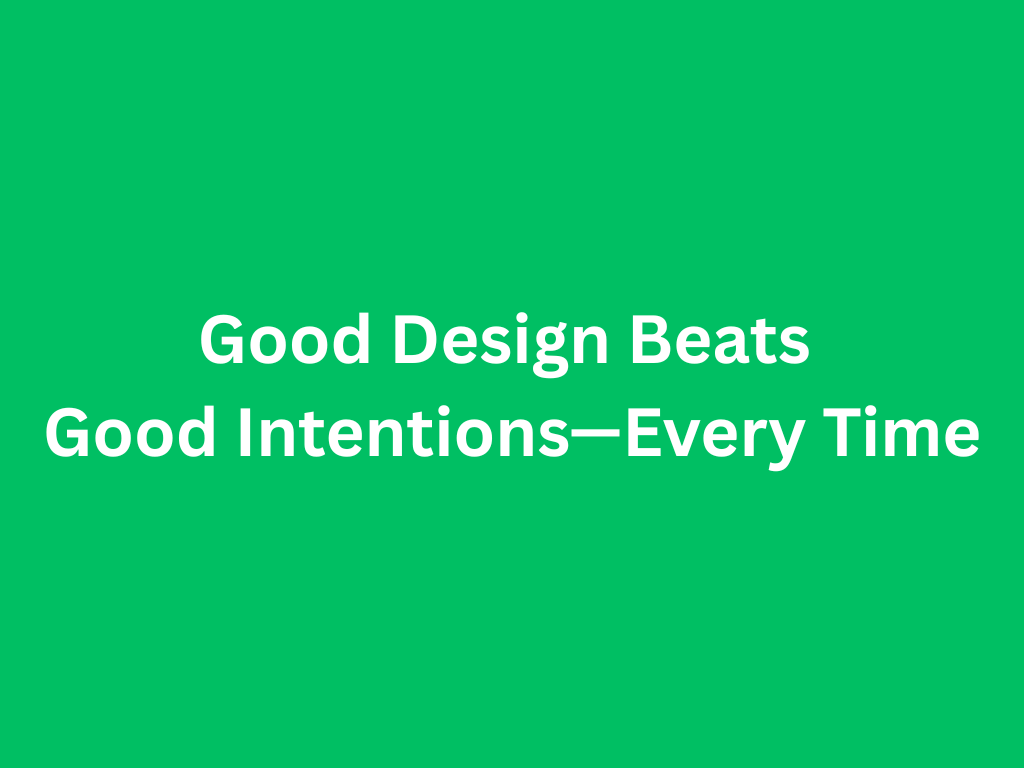- Green Building News
- Posts
- 🌱Good Design Beats Good Intentions—Every Time
🌱Good Design Beats Good Intentions—Every Time


Smart strategies. Sharp stories. Sustainability that sticks.

📬 Intro: Good Intentions Won’t Get You There
You’ve nailed your LEED checklist. You’ve installed every sign, poster, and prompt. But recycling bins are still overflowing, energy spikes at odd hours, and sustainability feels like constant nagging.
Here’s a radical idea: Ditch the signs. Design the space instead. This week’s Built to Last explores how behavioral design is quietly revolutionizing green spaces by making sustainability intuitive, not instructive. Before we jump in, here’s what’s happening across the field.
A MESSAGE FROM SKEMA
Tired of spending months turning schematics into BIM?
Skema.ai lets you do it in minutes (yes, really). This AI-powered tool takes your existing Revit, ArchiCAD, or IFC files and creates fully-integrated BIM models faster than you can say "value engineering." Already trusted by TVS Design and other industry heavyweights.
Want BIM in minutes, not months?
🌱 Field Notes: What We’re Watching
💡 Green Signal: Behavioral Nudges Deliver Real Waste Reduction
A 2025 systematic review of 99 experimental studies in Frontiers in Psychology shows that choice‑architecture tactics—strategic bin placement, timely feedback, and social‑norm cues—consistently cut waste and resource use across offices, schools, and hospitals. The most successful interventions made the sustainable choice feel instinctive. Read the study (https://www.frontiersin.org/journals/psychology/articles/10.3389/fpsyg.2025.1561467/full)
🏥 Unexpected Champions: Small‑Town Hospital Earns National Energy Award
Methodist Olive Branch Hospital (population ~40,000) slashed its energy intensity >15% over two years, winning ASHE’s 2025 Energy to Care Sustainability Champions award—proof that big impact doesn’t require a marquee name or massive budget. See the winners list (https://www.ashe.org/ashe-recognizes-energy-reduction-efforts)
🖥️ Occupancy Sensors That Pay for Themselves
A 2025 case study from LightNOW shows mwConnect’s Sacramento HQ cutting lighting power 69%—and saving 8.3 tCO₂e annually—by pairing wireless mesh occupancy sensors with HVAC set‑point tweaks. Total payback: <3 years. Explore the case study (https://www.lightnowblog.com/2025/02/mwconnect-hvac-lighting-controls-integration-case-study/)
🌳 Pocket Parks Punch Above Their Weight in Seattle
Seattle’s community‑led Garfield Super Block broke ground in June 2025, adding a climate‑adaptive garden, nature‑play pocket, and accessible walking loop. Early engagement surveys show residents plan to bike and compost more thanks to the easy‑to‑reach green space. Project details (https://www.seattle.gov/parks/about-us/projects/garfield-super-block-renovation)
🏛 BUILT TO LAST
Design Spaces That Invite the Sustainable Choice—Without Signs Your LEED plaque is impressive. Your sustainability report shines. Yet the trash bins overflow. What gives? We’re conditioned to think signage and education fix behavior. But human nature doesn’t work that way. Good design is the shortcut your building needs to become sustainably intuitive.
From Three Perspectives: How Behavioral Design Wins
🔹 The Architect’s Lens
HLW’s award‑winning “Light Fall” retrofit in New York City (2024) turned a former elevator shaft into a 16‑story, daylight‑fed stair wrapped in 5,000 miles of fiber‑optic strands. By turning the vertical journey into a sculptural experience, the design team made stair use the coolest route between floors—no nagging posters required. Post‑occupancy surveys report a sharp jump in stair traffic and a measurable dip in elevator demand. Read the Architect Magazine feature (https://www.architectmagazine.com/project-gallery/hlw-confidential-staircase-project_o/)
🔹 The Builder’s Perspective
Austin Energy’s Green Building program now counts 21,573 rated projects—and credits simple default tweaks (like pre‑specifying networked controls) for much of the savings. Builders report happier occupants and lower change‑orders. See the Austin Monitor report (https://austinmonitor.com/stories/2025/03/austin-energy-green-building-program-logs-21573-projects-since-its-creation/)
🔹 The Building Manager’s View
At Emory University (Atlanta), moving landfill bins out of offices and clustering recycling/compost stations cut contamination and pushed diversion back toward the campus’s 75% record high. View the Emory update (https://news.emory.edu/stories/2025/03/er_waste_vendor-04-03-2025/story.html)
Make Behavioral Design Your Blueprint:
Identify friction points. Where do sustainable choices feel inconvenient or unclear?
Subtly guide decisions. Use placement, lighting, and default settings—not lectures.
Celebrate success simply. One concrete result beats a 30‑page deck.
Iterate intuitively. If it feels forced, redesign the experience.
“Design that makes the right choice easy is always more powerful than telling people what they should do.”
The Blueprint
🧠 TL;DR: Sustainable behavior sticks when it feels intuitive, not forced.
🧰 Action Step: Pick one spot in your building where sustainability feels hard. Redesign it so the green choice is the default.
💬 Quote of the Week:
“Behavior change is a design problem, not a people problem.” — Dan Lockton, Behavioral Designer
RETROFIT THIS
That moment when your building tells a better sustainability story than your signs ever could. (Got a better meme? Hit "reply" and send us yours).
TOOLS DOWN
Sometimes, the most effective sustainability intervention... is invisible. Quiet design changes speak louder than signs ever could.
✍️ Brian Bollinger, our Head Writer, has helped everyone from green startups to Fortune 500 teams make Green Building strategy actually stick.
🌍 Charlie Cichetti, our Fearless Leader and LEED Fellow, has helped >150,000 professionals advance their green building careers and knows how to turn complexity into progress.
Let’s Green Up together.
Let’s Green Up together.
Are you excited to read next week's newsletter? |